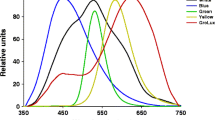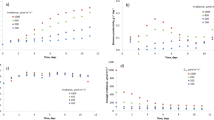Abstract
The diatomsChaetoceros sp.,Skeletonema costatum andThalassiosira pseudonana were grown with different irradiances of white and of blue-green light, and with a mixture of blue-green plus 6.5 μmol m−2 s−1 of white light. Exponential growth rates were higher in mixed blue for the first two, whileT. pseudonana grew faster in white light but, in all cases, mean cell division rates did not differ with increasing irradiances. Harvesting in stationary, rather than in late exponential growth phase, resulted in higher protein contents forChaetoceros sp. andS. costatum, but forT. pseudonana the highest value was in the exponential phase. The highest protein content was in blue-green light for the three species and it increased with irradiance. As to other fractions, the three strains showed different responses, related to quality and quantity, as well as to culture ages.
Similar content being viewed by others
References
Andersen RA, Jacobsen DM, Sexton JP (1991) Catalog of Strains. Provasoli-Guillard center for Culture of Marine Phytoplankton. West Boothbay Harbor, Maine U.S.A., 98 pp.
Bligh EG, Dyer WJ (1959) A rapid method of total lipid extraction and purification. Can. J. Biochem. Physiol. 37: 91–917.
Brown MR, Jeffrey SW, Garland CD (1989) Nutritional aspects of microalgae used in mariculture; a literature review. CSIRO Marine Laboratories. Report 205. Australia: 44 pp.
Chiaverini J (1972) Techniques d'extraction et d'analyse des lipides. Université de Paris. Station Zoologique Villefranche-Sur-Mer. Notes de Travail No. 12: 12 pp.
Dubinsky Z, Matsukawa K, Karube I (1995) Photobiological aspects of algal mass culture. J. Mar. Biotech. (in press).
Dubois M, Guilles KA, Hamilton JK, Rebers PA, Smith F (1956) Colorimetric methods for determination of sugars and related substances. Analyt. Chem. 28: 350–356.
Färber-Lorda J (1986) Etudes biologiques, energetiques et biochemiques du krill antartiqueEuphausia superba etThysanoessa macrura recolecte au cours de la Campagne Fibex. Ph.D. thesis. Univ. de Aix-Marseille. 214 pp.
Fernandez-Reíriz MA, Perez-Camacho A. Perreiro M, Blanco J, Planas M, Campos J, Labarta U (1989) Biomass production and variation in the biochemical profile (total protein, carbohydrates, RNA, lipids and fatty acids) of seven species of marine microalgae. Aquaculture 83: 17–37.
Flaak AR, Epifanio CE (1978) Dietary levels and growth of the oysterCrassostrea virginica. Mar. Biol. 15: 157–163.
Fogg GE, Thake (1987) Algal Cultures and Phytoplankton Ecology. The University of Wisconsin Press: 269 pp.
Gostan J, Lechuga-Deveze C, Lazzara L (1986) Does blue light affect the growth ofChastoceros protuberans (Bacillariophyceae). J. Phycol. 22: 63–71.
Guillard RRL, Ryther JH (1962) Studies of marine planktonic diatoms 1.Cyclotella nana Husdedt andDetonula confervacea (Cleve) Gran. Can. J. Microbiol. 8: 229–239.
Hauschild CHA, McMurter HJG, Pick FR (1991) Effect of spectral quality on the growth and pigmentation of pico cyanobacteria. J. Phycol. 27: 179–189.
Hellebust JA (1970) Light requirements for photosynthesis and growth rate. In Kinne O (ed.) Marine Biology 1. Wiley-Interscience, London: 125–158.
Lowry OH, Rosenbrough NJ, Farr AL, Randall RJ (1951) Protein measurement with the folin phenol reagent. J. Biol. Chem. 193: 265–275.
Malara G, Charra R (1972a) Dosages des proteines particulaires selon la méthode de Lowry. Université de Paris. Station Zoologique. Villefrenche-sur-Mer. Notes de Travail. No. 5: 11 pp.
Malara G, Charra R (1972b) Dosages des glucides particulaires de phytoplankton selon la methode de Dubois. Université de Paris. Station Zoologique. Villefrenche-Sur-Mer. Notes de Travail. No. 6: 12 pp.
Ojala A (1993) The influence of light quality on growth and phycobiliprotein/chlorophyll a fluorescence quotient of some species of freshwater algae culture. Phycologia 32: 22–28.
Pande SV, Khan RP, Venkitasubramanian TA (1963) Microdetermination of lipids and serum total fatty acid. Analyt. Biochem. 6: 415–423.
Sánchez-Saavedra MP, Voltolina D (1994) The chemical composition ofChaetoceros sp. (Bacillariophyceae) under different light conditions. Comp. Biochem. Physiol. 107B: 39–44.
Sánchez-Saavedra MP, Voltolina D (1995) The effect of different light quality on the food value of the diatomChaetoceros sp. forArtemia franciscana Kellogg. Riv. Ital. Acquacolt. 30: 135–148.
Senger H (1987) Blue light responses: Phenomena and Occurrence in Plants and Microorganisms. CRC Press Inc. Boca Raton. Vol. 1: 160 pp. Vol. 11: 169 pp.
Sokal RR, Rohif FJ (1979) Biometria: Principios y Metódos Estadísticos en la Investigación Biologica. H. Blume Ediciones, Barcelona: 832 pp.
Sukenik A, Carmeli Y, Berner T (1989) Regulation of fatty acid composition by irradiance level in theEustigmatophyta Nannochloropsis sp. J. Phycol. 25: 686–692.
Trujillo-Valle ML (1993) La colección de Microalgas del C.I.C.E.S.E. Comunicaciones Académicas. Serie Acuicultura CIAC9301. Centro de Investigación Cientifica y de Educación Superior de Ensenada, México: 103 pp.
Voskresenskaya NP (1972) Blue-light and carbon metabolism. Ann. Rev. Plant. Physiol. 23: 219–234.
Wallen DG, Geen GH (1971) Light quality in relation to growth, photosynthetic rates and carbon metabolism in two species of marine plankton algae. Mar. Biol. 10: 34–43.
Whyte JNC (1987) Biochemical composition and energy of six species of phytoplankton used in mariculture of bivalves. Aquaculture 60: 231–241.
Author information
Authors and Affiliations
Rights and permissions
About this article
Cite this article
del Pilar Sánchez-Saavedra, M., Voltolina, D. Effect of blue-green light on growth rate and chemical composition of three diatoms. J Appl Phycol 8, 131–137 (1996). https://doi.org/10.1007/BF02186316
Received:
Revised:
Accepted:
Issue Date:
DOI: https://doi.org/10.1007/BF02186316




